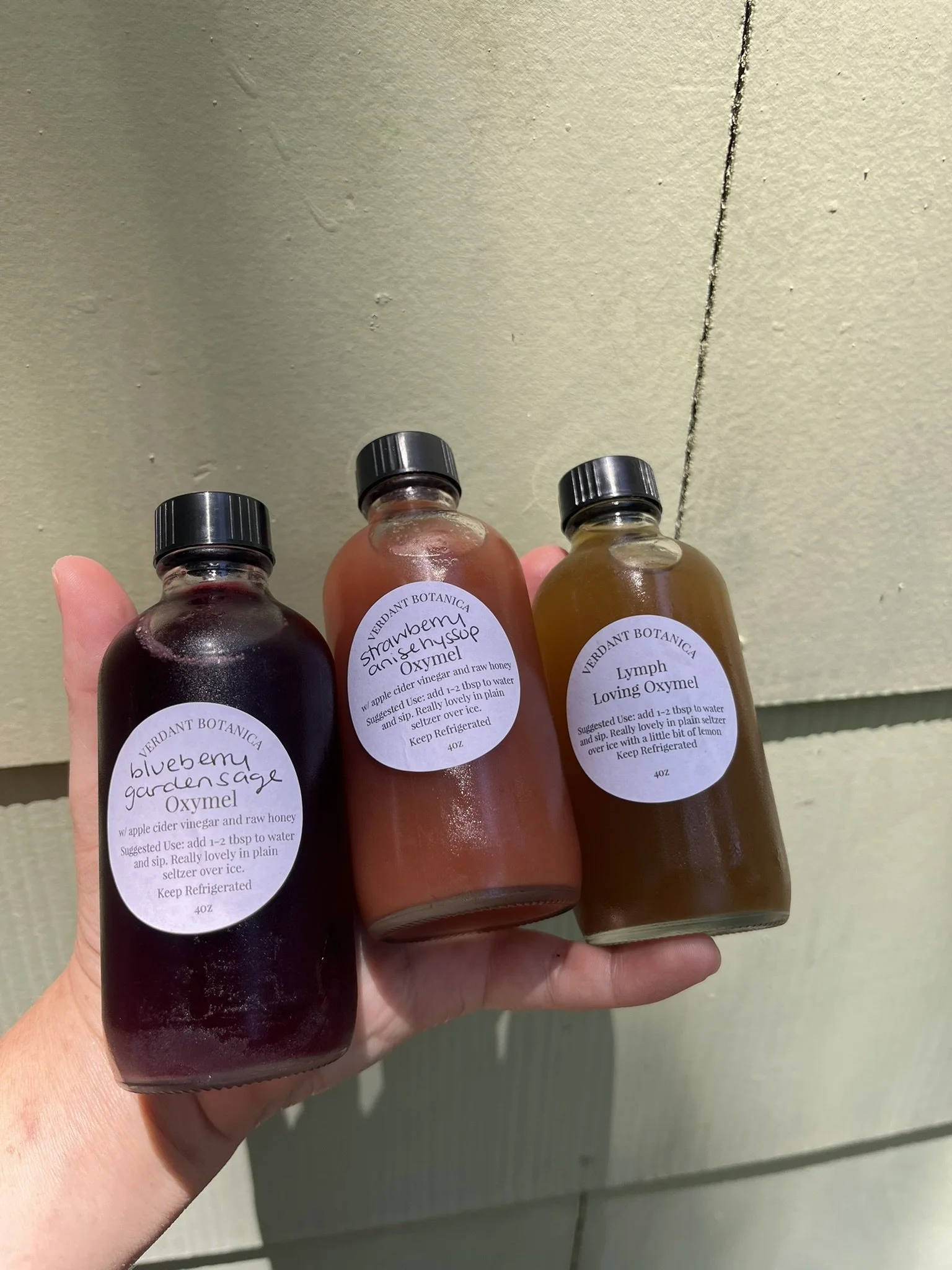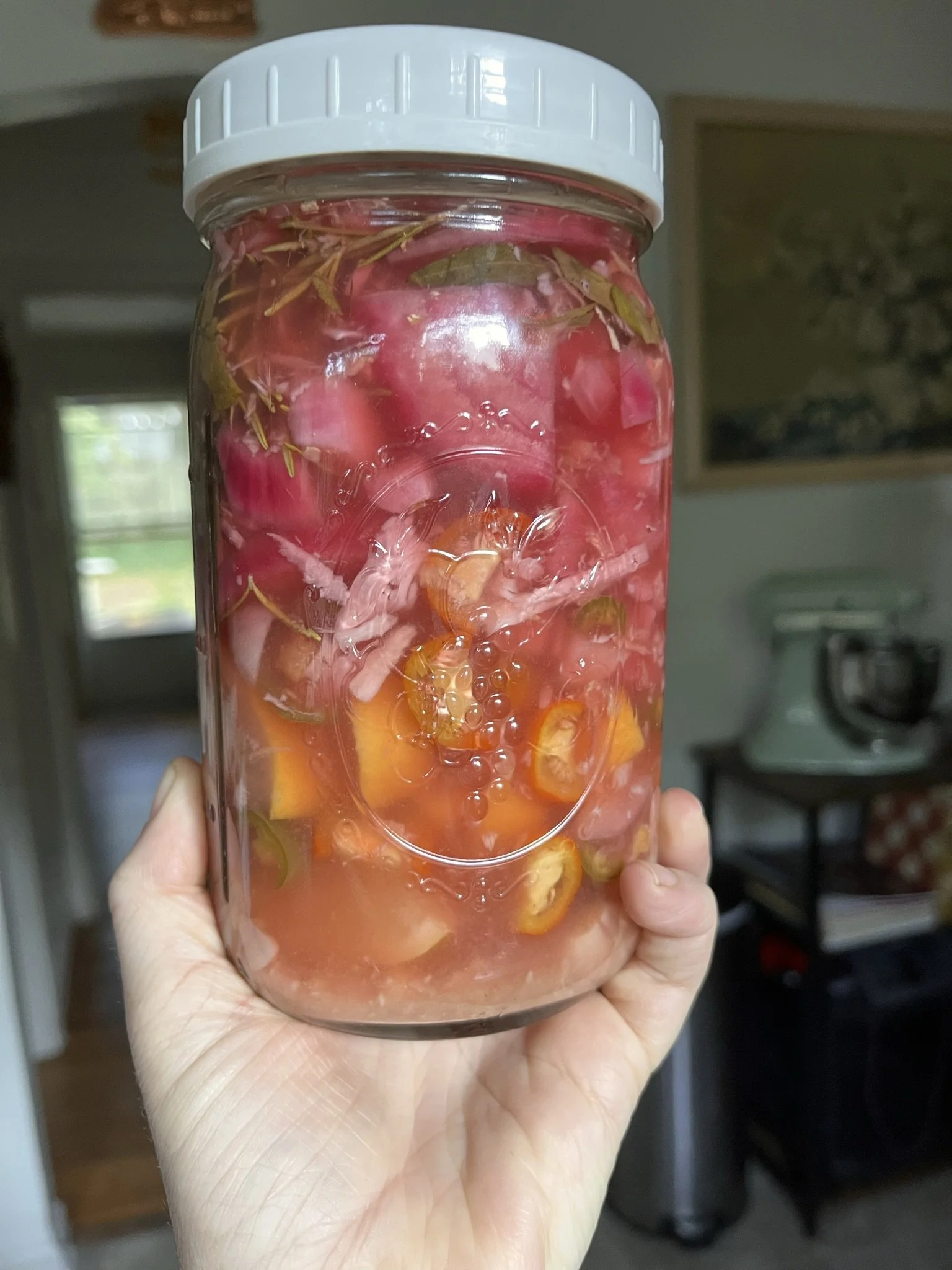Oxymels
Oxymels are a simple preparation that are endlessly versatile. Using honey and vinegar you can make a delicious herb and fruit infused syrup that can be used in a variety of ways. Originating out of Western Asian and Mediterranean regions, oxymel translates to acid + honey in Greek.
A well known oxymel would be Fire Cider- popularized by Rosemary Gladstar- it is a combination of many warming and immune stimulating herbs, fruits and vegetables that is taken at the first sign of illness.
Oxymels are great to make year round. During hot summers, the sour taste has such a cooling effect. And they offer great immune support during cold and flu season. This is a wonderful way to preserve the tastes of fruits and herbs to use later in various ways.
I really dont have a single way to make an oxymel. Sometimes I’ll let the fruit and herb infuse in the vinegar for a few days on my kitchen counter before adding the honey. Sometimes I’ll add the honey first if it's mostly herbs. Letting fruit and honey sit for a few days, especially in warm temps, will kick off a fermentation process and you will be on the way to making a mead. It's a great preparation to experiment with.
Most often though, I follow the guidelines below:
Fruit and Herb Oxymels:
I like making these for gifts or to have on hand to add to plain seltzer, cocktails, or mocktails.
I use fruits that are in season, ripe, and abundant with herbs that I think might compliment the fruit nicely. It's all an experiment!
Some combos that have worked nicely for me in the past are: Blueberry + Garden Sage, Strawberry + Anise Hyssop, Rhubarb + Ginger (no fruit technically in this one), Fig with Cardamom + Black Pepper, and Orange + Ginger.
Fill the jar about ½-⅔ full with your fruit and using a fork, spoon, or small masher- mash the fruit for about a minute.
If using fresh herbs- chop finely and mix into the fruit. If using dried herbs- grind finely and mix into the fruit. The amount of herb very much depends on your palate and the intensity of the herb itself. I love a strong herbal taste in my oxymels… I want to still taste the herb after I’ve added it to a seltzer. But that might overwhelm some.
For me, if I was using a 16oz jar to make an oxymel, using fresh herbs I would add about ¼ cup of chopped herb or about 1-2 tbsp of dried herb. If you’re not so sure, start with less.
Then pour honey over the fruit and herb combo until it is just about covered. After that, pour your apple cider vinegar all the way to the top. Mix it up to release any air bubbles and add more vinegar to make sure the fruit and herb are covered.
Leave the oxymel in a cool dark place in your kitchen, being sure to shake daily. When I am making an oxymel with fruit with a high water content I typically leave it to macerate for about 2 weeks. If the oxymel has more herbs in it, leave it for up to 4 weeks.
Once the mixture is done macerating, strain it and enjoy! You can also taste it along the way to assess the flavor- in case you want to add more herbs or if you aren’t sure if it is ready.
While this version of an oxymel has its medicinal value, I think of them more in a culinary sense.
Herbal Oxymels:
Oxymels, as a medicinal preparation, are typically used as gargles or for respiratory issues. But depending on what herbs you add, oxymels can support digestion, lymph function and more. Vinegar is an excellent menstruum for mineral rich herbs. And honey helps to make the preparation more palatable while also extracting the aromatic qualities from the herbs. If you know more about honey as a menstruum, please message me! I would love to learn more about this but haven’t quite had luck in my research endeavors.
For the most part I have made herbal oxymels using above ground parts along with ginger root. And some of my favorite ones to make are: orange peel, fennel seed, and ginger; milky oats (however, I start this one out differently, more on that below); any aromatic mint for respiratory support- like rosemary, sage, or thyme- these herbs can be intense, so you might not need a lot of oxymel for this. But they are great to gargle when your throat is sore or feeling a little sick.
The one I make most often is a garlic oxymel. It's best (always) to chop garlic about 15 minutes before cooking or use, since the more pronounced medicinal properties are catalyzed by oxygen. Based on the amount of garlic chopped up, cover with honey and aim for a 1:1 ratio of honey and apple cider vinegar. I will leave this in a dark cool corner of my kitchen for 2 weeks, but you can leave it up to 4 weeks. Once strained, put in the fridge. It's great to take at the first sign of illness. But honestly, good luck with keeping it around. It is so nice to use as a salad dressing base. The honey, acid, and garlic meld so well. You can add some oil, seasonings, and some mustard if you want and have a very easy and delicious salad dressing.
More on Milky Oats! A milky oat oxymel is a great alternative to a milky oat tincture using alcohol. For this you want to start by just making a vinegar based extract with fresh milky oats using a 1:2 ratio of mily oats and ACV, respectively. Blend the milky oat and vinegar with an immersion blender or whichever blender you tend to use. I’ll add honey after 2 weeks and let it macerate for another 2 weeks. I don’t add the usual amount of honey to this mixture, at most only half the amount of honey as there is vinegar. I might even add some ginger or other warming herbs, but it is quite fine on its own. Shake very well before you strain, because you want the latex (the milky part of the oat) to be suspended in the mixture and not be stuck at the bottom of your jar. If any is left at the bottom of the jar, use a spatula to get it out. And always be sure to shake your oxymel before taking it, for this same reason! You want that latex.
For digestion support, the bitter flavor of orange peels (chopped finely), along with fresh grated ginger, and ground up fennel seeds all work well with this type of preparation. Again, proportions are subjective, but I’d suggest filling a 16oz jar up halfway with finely chopped orange peel, grate about 1-1.5” of fresh ginger root into the jar along with 2 tbsp of freshly ground fennel seed. Cover with honey, fill the rest of the jar up with ACV and let it sit for a few weeks. Taste it while its macerating and see if you want a more pronounced ginger or fennel taste. Add more if you do, and let sit for a few more weeks.
Adding 1 oz of this to about 4-6 oz of seltzer is really refreshing before or after a meal.
This winter I have been making just a plain orange oxymel with all the citrus on sale, which has been lovely just on its own.
With all of the lovely mineral-rich greens that emerge early spring, making a lymph loving oxymel is a must. First, be sure you are 100% positive in your plant ID before infusing in vinegar! And be wary of where you are harvesting these herbs. They are abundant and grow in many places, and being mineral-rich they may take up toxins if growing in toxic areas. Many of these plants have an affinity to the lymph system, getting the lymph flowing again after a period of winter dormancy. And just offer an infusion of mineral salts, while also lending support to allergy season.
Ok, so now for the herbs! Chickweed, Cleavers, Nettles and Violets come to mind! I also like to add some warming culinary herbs that are waking up in the garden, especially garden sage. As well as ginger. I like the addition of something warming to help support the movement of the lymph. For this oxymel, I start with chopping all the fresh herbs, in whatever proportion you’d like. All equal parts are fine for the spring greens, especially if you like the taste of them all, but I would add a bit less of the garden sage since it has a strong flavor. You can add some other herbs to this if you’d like- calendula or echinacea root for example, but it is fine without! Grate about 1-2” of ginger and add to the jar. Fill a jar up halfway and for this one, cover with vinegar first. Let that mixture sit for 2 weeks before adding honey to it. Similar to milky oats, you don't need to add an equal proportion of honey, but maybe ½-¾ the amount of ACV. Let sit for another 2 weeks before straining! Add about 1 oz of this to some plain water or seltzer with a squeeze of lemon.
You can try to experiment to make some kid-friendly cough syrups using herbs your kid finds palatable (like anise hyssop, garden sage, rosemary, or even catnip if there is an upset stomach). And be sure to dilute it with water! And of course, no honey to children under the age of one!
Recipe Round-up:
Remember, you should experiment with your own oxymels based on your preferences! Below is more of a guide to follow, a skeleton of a recipe based on a 16oz jar. You can adjust proportions based on the size jar you are using and your own palette! You can do a 1:1 ACV and honey ratio, or a 2:1 if you’re fruit is high in sugar or you’d like it less sweet.
Fruit and Herb Oxymel Recipe ‘Skeleton’:
1 cup of fruit (either finely chopped or easily mashed when in the jar)
3-4 tbsp of finely chopped FRESH herb or 1-2 tbsp of DRIED herb
¾ cup of Raw Honey
¾ - 1 ½ cup of Organic Apple Cider Vinegar (depending on preference of sweetness)
Mix honey and ACV until honey is dissolved. In a jar mash up fruit to break it up, releasing the juice or breaking the skin. Add the herbs on top. Pour the honey and ACV mixture over it, being sure to cover all the fruit and herbs. Can add a splash more of ACV if needed to cover everything. Let sit for 2-4 weeks, tasting occasionally until it is to your liking. Strain and enjoy!
Some important things to note:
Use a jar with a plastic lid or put wax or parchment paper between the lid and the mixture. The vinegar will degrade the metal lid and you don’t want the disintegrating metal to get into your oxymel.
Keep out of direct sunlight while the mixture is macerating.
You can keep the mixture for about a year when stored in a cool, dark area in your house. But I highly recommend you keep your oxymel in the fridge for up to a year.
Honey sourcing: getting good quality honey isn't always easy and it certainly isn't cheap. Raw, local honey is best, but might not be financially accessible. But be wary of cheap grocery store honey, as these often contain fillers and are not pure honey.


